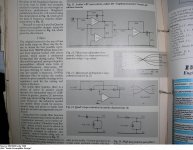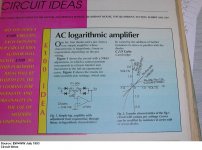No tone controls for me either. Sometimes the bass gets a bit too much but i've never known tone controls that didn't mess up the sound quality. Even DSP messes things up, a set of decent headphones easily proves that.
Oh, and "tone controls"?
Nothing better than 12dB (or more) of available boost with a 40watt amp running speakers that need more than one watt just to reach 90dB, eh? Which was a typical situation with amps and tone controls... etc....
Now in the hands of expert users, no worries... so folks like us are safe.
Nothing better than 12dB (or more) of available boost with a 40watt amp running speakers that need more than one watt just to reach 90dB, eh? Which was a typical situation with amps and tone controls... etc....
Now in the hands of expert users, no worries... so folks like us are safe.
Please define "selected"?
And also "designed carefully"? Is that the opamp or the circuit?
C'mon Bear, that is bordering on trolling. It clearly depends on the specific application, i.e. you have to do some engineering.
Especially with modern simulation tools (but accommodating that GIGO is real and one should be competent in the fundamentals first), we can have a pretty good idea the specific demands of any portion of a circuit. Source/Load/Feedback impedance, among so many other characteristics, will be driven by performance needs, and thus drive the correct selection of part(s) to work accordingly.
Haven't used them in years, always sound like an "effect" to me.😀 Anyways keeps jerk guests from turning up the bass all the way, any party always has one.
Active filters in crossovers, EQs, etc... are quite demanding too! High power gain is needed due to complex impedances.
Last edited:
Oh, and "tone controls"?
Nothing better than 12dB (or more) of available boost with a 40watt amp running speakers that need more than one watt just to reach 90dB, eh? Which was a typical situation with amps and tone controls... etc....
Now in the hands of expert users, no worries... so folks like us are safe.
Everyone knows I don't like bass, I'm not a musician but open low E is 41Hz? For guitar music the rest is just noise, unless you like the dropped A dark ambient bands and even they sound fine on my headphones.
Everyone knows I don't like bass, I'm not a musician but open low E is 41Hz? For guitar music the rest is just noise, unless you like the dropped A dark ambient bands and even they sound fine on my headphones.
What about some classics?
https://www.amazon.com/Albinoni-Adagio-Gary-Karr/dp/B0100WQGZA
However, you can hear it by a whole body, not just in headphones...
Not feeling the music with your body is one big reason I dislike using headphones (and small speakers).
Everyone knows I don't like bass, I'm not a musician but open low E is 41Hz? For guitar music the rest is just noise, unless you like the dropped A dark ambient bands and even they sound fine on my headphones.
Pipe organs, Bosendorfer Imperial... can go C0 (16.35Hz). Not exactly rock and roll instruments.
What are you listening to, bagpipes?

Last edited:
Haven't used them in years, always sound like an "effect" to me.😀 Anyways keeps jerk guests from turning up the bass all the way, any party always has one.
In most cases, a freq tilt circuit is what is needed. (1st attachment)
Due to it’s frequency balancing-unbalancing in a complementary way, it dissapoints the jerk guest and makes him to self correct his action.😀
I have shown some folks how to get a tube sound by using inverse parallel diodes in an opamp feedback loop and mixing some of the resulting distortion back into the main signal chain.
Ed, looking for the tilt circuit, I found this (2nd attachment).
Is the log function what emulates the tube sound?
George
Attachments
I'd say that most CDs produced in the '80s can use a good dose of both bass and treble boost (not only tilt).
People use germanium diodes, silicon signal diodes, rectifier diodes, LEDs, Mosfets, whatever.
...and tantalum capacitors in critical tone control circuits, too. Sometimes it's a trick that sounds good.
...and tantalum capacitors in critical tone control circuits, too. Sometimes it's a trick that sounds good.
C'mon Bear, that is bordering on trolling. It clearly depends on the specific application, i.e. you have to do some engineering.
Especially with modern simulation tools (but accommodating that GIGO is real and one should be competent in the fundamentals first), we can have a pretty good idea the specific demands of any portion of a circuit. Source/Load/Feedback impedance, among so many other characteristics, will be driven by performance needs, and thus drive the correct selection of part(s) to work accordingly.
Yes, I also heard the heavy breathing under the bridge and walked around 😎
I've been baiting the bear though, so do deserve it 😱
...and tantalum capacitors in critical tone control circuits, too. Sometimes it's a trick that sounds good.
Tantalum is much better than aluminium oxide, except when fails with zero resistance. 😀
Tantalum is much better than aluminium oxide, except when fails with zero resistance. 😀
= mini 4th of July. Quite impressive silver and gold sparkles for a surprising amount of seconds!
Everyone knows I don't like bass, I'm not a musician but open low E is 41Hz? For guitar music the rest is just noise, unless you like the dropped A dark ambient bands and even they sound fine on my headphones.
No Dafos for you, Scott?
No big marching bands?
No freight train rumblings?
What, no pipe organs then??
_-_-
PS. the 5 string bases have a C as the low note, afaik...
Yes, I also heard the heavy breathing under the bridge and walked around 😎
I've been baiting the bear though, so do deserve it 😱
Well, statements like opamps = straightwire with gain, might serve to give one "king of the trolls" candidacy.
Very effective (plus cost and space saving)
Thank you Wavebourn 🙂
George
+1 gpapag
I haven't tried this yet (well I did but it didn't improve anything)
To be honest, as 'green' as I am, and due to the somewhat satirical nature of the thread, I wasn't totally sure if Wavebourn was being totally serious.
I see reduced gain and power, but stabilisation of the gain, so I guess Wavebourn suggestion was serious.
This thread makes my head hurt! 😀
Since then I have p***ed about making simplistic OPA541 amplifiers, with better results.
Next up is a high current resistance bridge with multiple OPA549 OPS in CC mode
- Status
- Not open for further replies.
- Home
- General Interest
- Everything Else
- What is wrong with op-amps?

